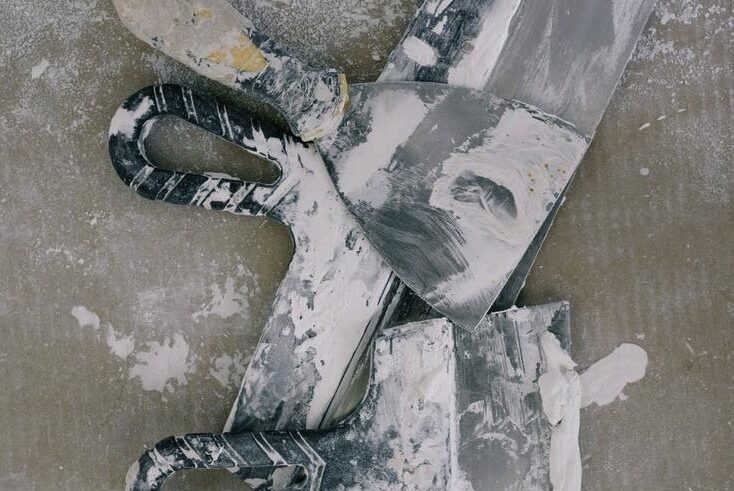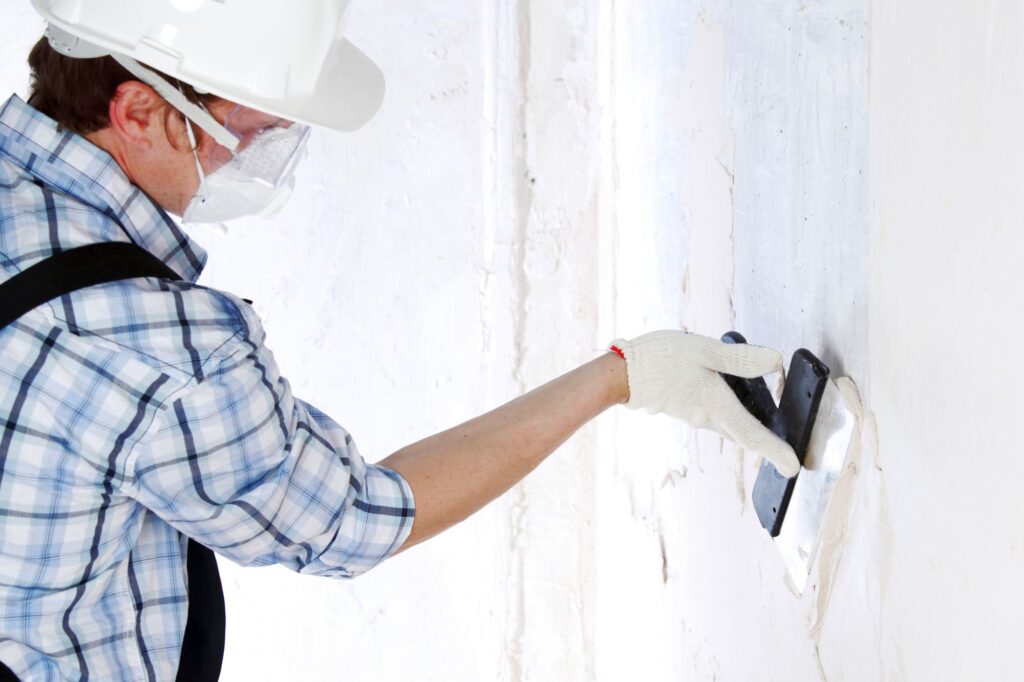Plastering is a critical step in construction that smooths surfaces and prepares them for painting or other finishes. However, defects can arise due to poor quality, incorrect materials, or environmental factors.
These imperfections can significantly impact a building’s appearance and durability. This article will examine the common plastering defects, their causes, and practical solutions.
Let’s get straight to the point.
Plastering is essential for smooth, durable walls, but defects can arise due to poor materials, improper application, or environmental conditions. Common issues include cracking from shrinkage or structural movement, efflorescence caused by moisture and salt deposits, and blistering due to trapped air or excess moisture.
Poor adhesion, incorrect mix ratios, and inadequate curing often cause peeling, debonding, and softness. Weather conditions, high humidity, and improper layering can impact plaster quality.
Proper surface preparation, balanced mix ratios, and controlled drying are essential for preventing defects. Following best practices can significantly improve plaster durability and aesthetic appeal.
Importance Of Plastering In Construction

Plastering serves both aesthetic and functional purposes in construction. When applied correctly, it provides a smooth surface for painting, protects structural elements, and can even contribute to fire resistance and soundproofing.
However, subpar plasterwork can lead to various issues, affecting the building’s visual appeal and integrity.
Common Plaster Defects And Their Causes
Plaster defects are frequent construction issues that impact aesthetics and durability. Addressing these issues promptly and understanding their causes can help maintain the quality of plastered surfaces.
This comprehensive guide explains common plaster defects, their causes, and best practices for preventing and fixing them.
1. Cracking In Plaster
Cracking is among the most prevalent issues in plasterwork. It often results from factors affecting the surface’s appearance and structural integrity.
Causes of Cracking
- Drying Shrinkage: Rapid water evaporation from the plaster mix leads to shrinkage and cracking. This typically happens in hot or dry conditions.
- Structural Movement: Natural shifts or movements in the building’s structure can lead to cracks in the plaster, particularly if the plaster is not flexible enough to accommodate these changes.
- Incorrect Mix Ratios: Using a mix with too much cement can result in non-structural cracks due to the plaster’s increased rigidity.
- Poor Application Techniques: Applying plaster over a base that has not adequately dried or cured (often referred to as a “green” undercoat) can cause stress cracks as the underlying layer continues to dry and shrink.
Preventive Measures
- Balanced Plaster Mix: Ensure the right ratio of materials in the mix to prevent excessive shrinkage.
- Adequate Drying Time: To avoid trapping moisture, allow each layer of plaster to dry thoroughly before applying the next.
- Timing: Avoid plastering during extremely hot or dry conditions to minimise the risk of rapid drying.
2. Efflorescence: Understanding The White Deposits
Efflorescence is characterised by white, powdery deposits on plaster surfaces caused by soluble salts moving to the wall’s surface. This issue is unsightly and can indicate deeper moisture problems within the structure.
Causes of Efflorescence
- Soluble Salts in Materials: These salts naturally present in building materials dissolve in moisture and migrate to the surface.
- High Moisture Levels: Leaks or insufficient damp-proofing can increase moisture content, accelerating efflorescence.
- Inadequate Sealing: Poorly sealed surfaces allow moisture to penetrate, exacerbating the problem.
Solutions
- Use of Desalinated Water: Mixing plaster with desalinated water can reduce the presence of salts.
- Surface Sealing: Properly seal all surfaces to prevent moisture ingress.
- High-Quality Cement: Employ premium cement products to minimise the chance of salt contamination.
3. Blistering: Causes And Prevention
Blistering occurs when small, raised areas form on the plaster surface due to trapped air or moisture. It can weaken the plaster’s adhesion to the wall, leading to potential peeling or cracking.
Common Causes
- Excess Moisture: Application on a damp wall or using a water-heavy plaster mix can create blisters.
- Poor Surface Preparation: Dirt, grease, or old paint layers can prevent proper adhesion.
- Heat Exposure: Direct sunlight or high temperatures during curing can cause rapid drying and blistering.
Recommendations
- Surface Cleaning: Ensure the surface is clean, dry, and contaminant-free before plastering.
- Protect from Sunlight: Shield fresh plaster from direct sun and wind to allow for even drying.
4. Peeling And Flaking Of Plaster
Peeling and flaking occur when the outer layer of plaster fails to adhere properly to the substrate, causing sections to come away from the wall. This can significantly reduce the surface’s aesthetic appeal and integrity.
Reasons for Peeling and Flaking
- Poor Bonding: Lack of adhesion between layers is a primary cause.
- Incorrect Plaster Composition: Using an unsuitable plaster blend can lead to instability.
- Insufficient Curing Time: Not allowing the plaster to cure adequately can result in weak bonds.
Preventive Actions
- Surface Preparation: Clean and apply a bonding agent to ensure strong adhesion between layers.
- Curing: To help the plaster develop its full strength, maintain the correct curing conditions for at least ten days.
Structural Issues In Plastering

1. Debonding: Why Plaster Doesn’t Stick
Debonding occurs when the plaster fails to stick properly to the substrate. When tapped, this defect often results in hollow sounds. If not addressed early, this defect can be particularly problematic.
Causes
- Contaminated Surfaces: Dust or oil on the wall can prevent proper bonding.
- Lack of Moisture: A sufficient wall dampening before applying plaster can lead to poor adhesion.
- Excessive Thickness: Applying too-thick coats of plaster increases the likelihood of debonding.
Solutions
- Clean the Surface: Remove dust and grease before applying plaster.
- Cement Slurry: Apply a thin layer of cement slurry to improve adhesion.
- Layer Control: Apply thin, even layers, allowing each to dry properly before adding more.
2. Softness In Plaster
Soft plaster often indicates an issue with the plaster mix, primarily a lack of cement or the use of poor-quality materials.
Testing for Softness
- Scratch Test: Scratch the plaster surface with a coin or key. If the scratch penetrates easily, it indicates a lack of hardness.
Recommendations
- Correct Ratios: Ensure the sand-to-cement ratio is precise.
- Quality Materials: Use clean, well-graded sand and avoid adding unnecessary water.
Environmental Factors Influencing Plaster Defects
1. Weather Conditions And Their Impact
Weather plays a critical role in plastering’s outcome. Conditions such as wind, heat, and humidity can all influence how well plaster adheres and cures.
Preventive Measures
- Timely Application: To avoid the day’s intense heat, perform plastering in the late afternoon or evening.
- Hydration Control: Like concrete, plaster requires adequate moisture to cure correctly. Keep the surface damp as needed.
2. High Humidity’s Effect On Plaster
High humidity can soften the plaster surface, making it prone to deformation and loss of structural integrity.
Recommendations
- Avoid Humid Conditions: Do not plaster when the air is very humid or during wet weather.
- Allow Drying: Ensure each layer dries thoroughly before applying the next.
Advanced Defects In Plastering
1. Plaster Delamination: Layer Separation
Delamination occurs when individual layers of plaster separate from each other or the wall substrate, often due to improper application methods.
Causes
- Poor Surface Cleaning: Dust and debris prevent a solid bond.
- Incorrect Curing: Failing to allow the undercoat to dry properly before applying the finish.
Solution
- Proper Bonding: Always clean and prepare the wall with a bonding agent before application.
2. Fragmentation And Bubbling
Bubbling, or popping, typically results from burnt lime or organic materials reacting with water within the plaster.
Prevention
- Matured Lime: Use lime that has been well-aged to reduce its reactivity.
- Balanced Mix: Avoid excessive lime content that can cause delayed reactions.
Best Practices For Avoiding Plaster Defects
Surface Preparation
- Cleaning: Always start with a clean, debris-free surface.
- Dampening: Moisten the wall to aid in adhesion before plastering.
- Roughening: Avoid overly smooth surfaces unless necessary roughening has been done.
Plaster Mix Quality
- Layering Techniques: Use appropriate ratios for scratch, brown, and finish coats.
- Water Control: Do not overwater the mix to maintain plaster integrity.
- High-Quality Ingredients: Invest in good-quality cement and sand for best results.
Curing Techniques
- Consistency: Maintain a consistent curing environment to help the plaster develop its strength.
- Protection: Cover fresh plaster to protect it from the elements and prevent rapid drying.
Conclusion
Proper materials, application techniques, and environmental control can manage plaster defects like cracking, efflorescence, blistering, and peeling.
Following these guidelines ensures the plaster’s durability and aesthetics, enhancing the construction’s appearance and lifespan.
Frequently Asked Questions About Plaster
What Are the Causes of the Defects in Plaster?
The cracks can be formed due to thermal expansion or rapid drying, movements in the background or in the Plaster itself, improper preparation of the old surface, poor quality, or excessive shrinkage of the Plaster, which occurs when the coat is too thick.
What Is the Cause of Blistering in Plastering?
The bubbling of plaster walls is caused due to the rise of dampness through the wall. The Plaster crumbles out, and the powdered mix falls down the adjacent floor. The rise of moisture through the wall is caused by the absence of a damp-proof course, bad site drainage issues, or inadequate sub-floor ventilation.
What Causes Plaster to Flake?
Peeling from plaster could be a result of insufficient wet troweling of the white coat when the plaster was originally applied, causing chalking of the surface. Very hard plaster may be slick, reducing the adhesion of any coating.
Does New Plaster Always Crack?
It is normal for a new Plaster to get hairline cracks as it dries out due to shrinking material. It is especially prominent around ceilings if you have had new plasterboards.
How Do You Repair Water-Damaged Plaster Walls?
Patching Plaster and Drywall
Ready-mixed spackling compounds, which come in small tubs, work well for this. Use a putty knife to apply the material to all damaged areas. Wipe away the excess with a damp rag or sponge and let dry. If the product shrinks when it dries, apply another coat.

